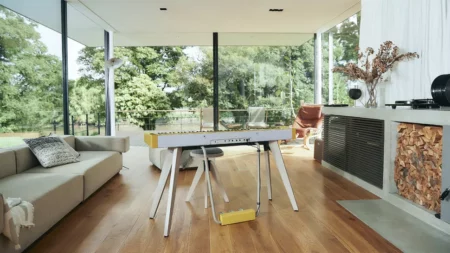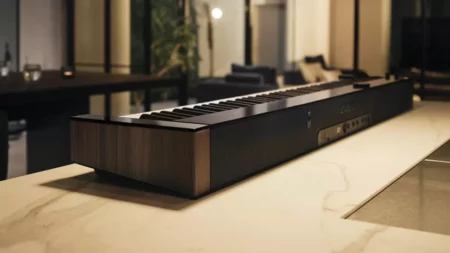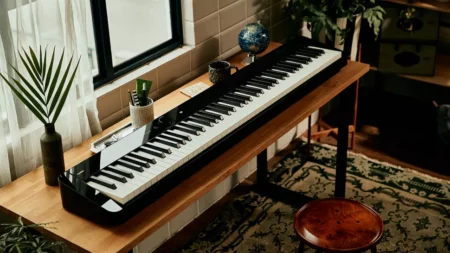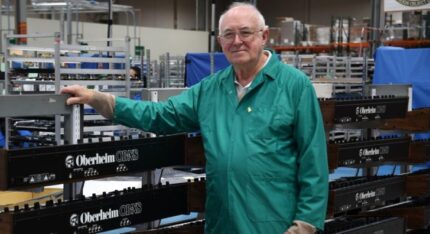Casio introduces High-End with Mid-Century Modern Styled Privia Digital Pianos
Casio’s new premium Privia digital pianos are designed to look and sound great from any angle.
Casio has introduced the Privia range, keyboards that they say are “the best-sounding, best-feeling, best-looking Privia ever made.”
We’re all in favour of digital piano manufacturers taking a few more risks with the designs of their instruments, so let’s take a moment to celebrate Casio’s new PX-S7000, PX-S6000 and PX-S5000, the latest additions to its Privia range.
With a design that’s “in harmony with modern lifestyles,” these pianos not only offer a more contemporary aesthetic, but are also intended to look great from all angles. So, there is no need to place them up against a wall if you do not want to.
The Privia PX-S7000 is striking – looking a bit like a modern take on the iconic mid-century modern Hohner Clavinet D6 design.
The hybrid keyboard, meanwhile, is made of both resin and wood, and promises an expressive key mechanism with natural touch. The main body of the PX-S7000 can be detached from the stand and played anywhere, thanks to its optional 8xAA battery power. An optional SP-34 three-pedal unit can be connected for portable use, and the optional SC-900 carrying bag lets you take PX-S7000 anywhere.
The PX-S7000 features the sound of three of the finest pianos on Earth, dubbed Berlin, Hamburg and New York. Each piano has its own unique personality, and the Multi-Dimensional Morphing AiR Sound Source brings them to life with damper, string, and aliquot resonance, plus subtle mechanical sounds.
The keyboard features 400 Tones, including 50 electric piano Tones, and a variety of Tones inspired by the keyboard parts of well-known songs.
The PX-S7000’s features a 32-watt 4-way Spatial Sound System. The speaker system in the flagship PX-S7000 takes this into account; you can choose an acoustic setting to match where you piano is positioned (against a wall, in the centre of a room or on a table) and the sound will then be adjusted and optimised in each of the four speakers.
The PX-S7000 also boasts a transparent acrylic music stand and is offered in a striking, bang-on-trend ‘harmonious mustard’ colour scheme, which is designed to “harmonise beautifully with virtually any room’s interior”. You can also bottle it and have it in black or white, but mustard is definitely the way to go, in our humble (but correct) opinion.
You’ll find the same speaker system and keyboard in the PX-S6000, which is available exclusively in black. In fact, its specs look pretty similar to those of the PX-S7000, though it has fewer built-in sounds (350 as opposed to 400) and a slightly reduced feature set. The stand and fixed pedals aren’t included, either, though they can be purchased separately.
One thing the PX-S6000 has over the PX-S7000 is the Tone Modify function, which enables you to fine-tune your sounds in real-time. You can also do this on your mobile device using the Casio Music Space app, which syncs via the included wireless MIDI/audio Bluetooth adapter. This also enables tone editing on the PX-S7000.
We should also point out that both the PX-S7000 and PX-S6000 have pitchbend wheels – a useful feature that we wish more digital pianos had.
Finally, there’s the PX-S5000, the most affordable of the new pianos. This has the same keyboard as its pricier siblings but strips things back by having just 23 tones and fewer features. Again, the stand and pedals are sold separately for this one.
PX-S7000 Features:
- 400 Tones including three legendary concert grand pianos (Hamburg, New York, and Berlin)
- New Smart Hybrid Hammer Action keys with spruce sides
- Beautiful design in your choice of Harmonious Mustard, Black or White finishes
- Matching beech stand with three fixed pedals
- Illuminated touch sensor controls with assignable multi-function buttons
- LED touch ring and bright, backlit LCD display for easy navigation
- Illuminated pitch bend wheel and assignable buttons
- Microphone input with volume control and 25 dedicated microphone effects
- Includes WU-BT10 Bluetooth Audio & MIDI adapter
- Dual headphone outputs plus 1/4″ L/R outputs and expression pedal input
- Class-compliant USB port with no drivers or installation needed
- MIDI recorder, USB audio recording and audio/MIDI file playback
- Optional 8xAA battery power (AC adapter included)
- Designed to work with the Casio Music Space app for iOS/Android
The Casio Privia PX-S7000HM will be available in October, in three color options, for $2,699.99/£2,249, the PX-S7000WE/BK will cost $2,499.99/£2,099, the PX-S6000 will be available for $2,399/£1,499 and the will be PX-S5000 offered at $1,199/£999. Find out more on the Casio website.





